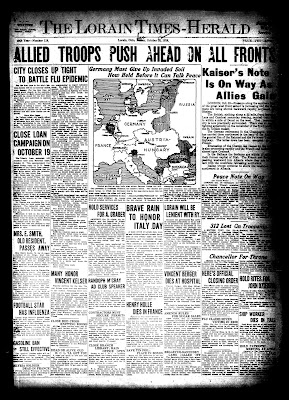The Spanish flu reared its ugly head on the front page of the October 5, 1918
Lorain Times-Herald (shown above),
affecting a family on the East Side, as well as a pair of Lorain soldiers stationed at camps.
The Lorain couple and their daughter, who lived on Georgia Avenue, were noted to be “suffering from an ailment which has been diagnosed as Spanish influenza.” The parents were doing better, but their daughter was still bedridden.
At Camp Sherman in Chillicothe, Ohio, a news bulletin hopefully stated, “The situation virtually is unchanged, but with encouraging reports from the base hospital because of the diminishing number of new cases reported, medical authorities today believed that the epidemic here of Spanish influenza, bronchitis and pneumonia has been broken.”
Sadly, Vincent Bonomonnio, a Lorain soldier at Camp Sherman, had passed away the previous day of pneumonia. “He was in Lorain on a visit last Sunday and at that time suffered with a severe cold,” the news article reported.
M. Venatius Moriarty, another Lorain soldier, died of pneumonia the previous day as well. He had been stationed at Camp Taylor in Kentucky.
Another Lorain soldier perished at Camp Taylor as reported on the front page of the October 7, 1918 Times-Herald.
Paris J. Plumb, aged 31, died of pneumonia, following the Spanish flu. His body was to be escorted back to Lorain by one of his brothers, Sergeant Harry Plumb, who was stationed at Camp Sherman.
On a positive note, four graduates of St. Joseph’s hospital volunteered for service at Camp Taylor to help with the influenza epidemic. Miss Marie Strohmeier of Elyria; Miss Stella Miller of Amherst; and Miss Clara Zimmerman and Miss Pauline Curran, both of South Lorain. Two other Lorain volunteers – Mrs. Effie Teemer and Mrs. Edward Kaufman – were already headed to Camp Taylor to help with the more than 8,200 cases of influenza.
The October 8, 1918 Times-Herald included information from Dr. Valloyd Adair, Lorain’s city health officer, as to how to prevent an epidemic in Lorain. “Those who wish to avoid contracting the disease should stay away from public gatherings and especially avoid contact with persons showing evidence of catarrhal symptoms,” he suggested.
Elsewhere on the front page, Lorain went about the unhappy task of conducting funeral services for the young men struck down by the disease; the Surgeon General offered a free pamphlet about the Spanish Influenza that was available to anyone who wrote and requested a copy; and Camp Sherman reported that the total number of deaths since the beginning of the influenza epidemic had grown to about 530.
The news was getting significantly worse on the front page of the October 9, 1918 Lorain Times-Herald. The number of cases in Lorain was increasing, with five in one family alone. School officials awaited instructions from the state authorities as to how to control the influenza in schools.
(On the same page, a small article noted that former Lorain photographer
W. A. Leiter had enlisted in the ordinance department of the army.
The situation on the front page of the October 10, 1918 Times-Herald wasn’t much better. A story with the heading, “ESTIMATE 200 HAVE INFLUENZA” noted, “City and health officials are watching the situation and are prepared to carry out any measures which may be recommended by the government or state to check the spread of the disease.”
It was becoming apparent that drastic action was needed, and the front page of the Friday, October 11, 1918 edition of the Times-Herald revealed the plan.
“CLOSE UP CITY TO FIGHT FLU” was the headline. “All moving picture shows, theaters, churches and Sunday schools, public, private and parochial schools and dance halls are closed until further notice, and all public or private gatherings of groups of people are prohibited,” noted the article. “All loafing and congregating in pool and billiard halls, soda and soft drink parlors and saloons in Lorain is prohibited by a proclamation issued by Mayor A. J. Horn this morning.
“Every person in Lorain is directed to comply with the necessary order reached at a decision of the health board.
“Police and other city officials will enforce the order."
The October 12, 1918 Times-Herald acknowledged the grim truth.
“The first great national epidemic is sweeping the country," noted an article on the front page. "The Spanish influenza is taking a heavy toll of lives in army camps and in cities. Thousands of persons are ill with the disease and still more deaths are expected.”
“For the first time in the city’s history, Lorain will be an entirely closed town Sunday,” the article stated. “For the first time on record every church in the community will have its doors closed and theaters will be closed for the first time since they were permitted to operate."
Lodges suspended meetings, clubs and societies abandoned their sessions, and funerals were banned.
Sprinkled among the other items on the front page were articles about the impact of the influenza in other states, more local cases, and reports of what were probably the last funerals to be held for a while.
Sadly, the October 14, 1918 edition of the Times-Herald included the first deaths in Lorain caused by the flu. Both of the deceased were from St. Louis, Missouri.








No comments:
Post a Comment